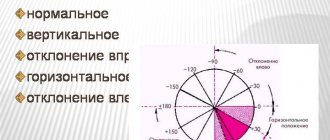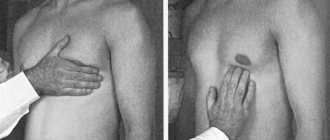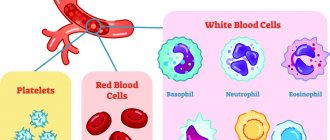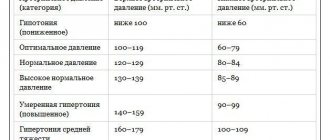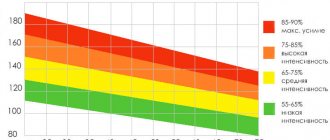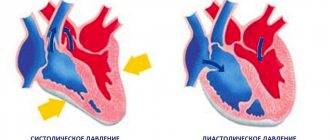The first phonendoscopes were folded sheets of paper or hollow bamboo sticks, and many doctors used only their own organ of hearing. But they all wanted to hear what was happening inside the human body, especially when it came to such an important organ as the heart.
Heart sounds are sounds that are produced during the contraction of the myocardial walls. Normally, a healthy person has two tones, which may be accompanied by additional sounds depending on what pathological process is developing. A doctor of any specialty must be able to listen to these sounds and interpret them.
Cardiac cycle
The heart beats at a rate of sixty to eighty beats per minute. This, of course, is an average value, but ninety percent of people on the planet fall under it, which means it can be taken as the norm. Each beat consists of two alternating components: systole and diastole. The systolic heart sound, in turn, is divided into atrial and ventricular. This takes 0.8 seconds, but the heart has time to contract and relax.
Systole
As mentioned above, there are two components involved.
First comes atrial systole: their walls contract, blood under pressure enters the ventricles, and the valve flaps slam shut. It is the sound of the closing valves that is heard through a phonendoscope. This entire process lasts 0.1 seconds. Then comes ventricular systole, which is a much more complex job than what happens with the atria. To begin with, we note that the process lasts three times longer – 0.33 seconds.
The first period is ventricular tension. It includes phases of asynchronous and isometric contractions. It all starts with the fact that an eclectic impulse spreads throughout the myocardium. It excites individual muscle fibers and causes them to spontaneously contract. Because of this, the shape of the heart changes. This causes the atrioventricular valves to close tightly, increasing blood pressure. Then a powerful contraction of the ventricles occurs, and the blood enters the aorta or pulmonary artery. These two phases take 0.08 seconds, and in the remaining 0.25 seconds the blood enters the great vessels.
In Dahl's dictionary
m. French music every sound, ringing, hum, voice; and every change in sound is an increase or decrease in tone. Hit the tone, hit the given note. | music sound quality or language. Good and bad violin tone. This piano has a full, thick and soft tone. The tone of string instruments is sharper than that of wind instruments. | music mode, which is major (dur) and minor (mol), and in each there are also divisions, according to the number of notes; in our church music, tone and mode are replaced by voices. | Painter. the degree of brightness or dominance of one or another color or paint; commonality of paint, suit. | The commonality of a person’s speech and techniques, the way he treats people. A man of good taste, who knows all social decency. He speaks in the tone of a teacher, or a boss. Set the tone, show off, show off. | See ton. Tonic, main note, dominant sound, tonic note, main note in tone. Tonic meter of poetry, melodious, Russian, based on word (and not syllable) stress. | doctor. tonic spasms, from excessive muscle tension, opposite sex. clonic. - a drug for the nerves.
Diastole
Here, too, everything is not as simple as it might seem at first glance. Ventricular relaxation lasts 0.37 seconds and occurs in three stages:
- Protodiastolic: After blood has left the heart, the pressure in its cavities decreases and the valves leading to large vessels close.
- Isometric relaxation: the muscles continue to relax, the pressure drops even more and becomes equal to the atrial pressure. This causes the atrioventricular valves to open and blood from the atria enters the ventricles.
- Ventricular filling: Following a pressure gradient, fluid fills the lower chambers of the heart. When the pressure equalizes, the flow of blood gradually slows down and then stops.
Then the cycle repeats again, starting with systole. Its duration is always the same, but diastole can be shortened or lengthened depending on the speed of the heartbeat.
Note-octave system
In general, the range of sounds potentially audible to the human ear covers almost 11 octaves. Because our course is devoted to musical literacy, we are only interested in musical sounds, i.e. approximately 9 octaves. To make it easier to remember octaves and the corresponding pitch ranges, we recommend going from top to bottom, i.e. from the upper range of sounds to the lower. For ease of memorization, we indicate the pitch in hertz for each octave in the binary system.
Octaves (names) and ranges:
- Fifth octave – 4096-8192 Hz.
- The fourth octave is 2048-4096 Hz.
- Third octave – 1024-2048 Hz.
- The second octave is 512-1024 Hz.
- The first octave is 256-512 Hz.
- Small octave – 128-256.
- Large octave – 64-128 Hz.
- Contractave – 32-64 Hz.
- Subcontractave – 16-31 Hz.
It makes no sense to consider other octaves in the context of musical sounds. Thus, the highest note for men is “F sharp” of the 5th octave (5989 Hz), and this record was set by Amirhossein Molai on July 31, 2021 in the city of Tehran (Iran) [Guinness World Records, 2019]. Singer Dimash from Kazakhstan reaches the note “D” in the 5th octave (4698 Hz). But the human ear cannot perceive sounds below 16 Hz. You can study the complete table of notes corresponding to frequencies and octaves in the following picture:
The 1st note of the first octave is highlighted in purple, i.e. the “C” note, and the green one is the “A” note of the first octave. It is to her, i.e. at a frequency of 440 Hz, all tuners for measuring pitch are preset by default.
Notes in an octave: notation options
Today, different methods are used to indicate that a note (pitch) belongs to different octaves. The easiest way is to write down the names of the notes as they are: “do”, “re”, “mi”, “fa”, “sol”, “a”, “si”.
The second option is the so-called “Helmholtz notation”. This method involves designating notes in Latin letters, and belonging to the octave - in numbers. Let's start with the notes.
Sheet music according to Helmholtz:
- C = "before".
- D = "re".
- E = "mi".
- F = "fa".
- G = "salt".
- A = "la".
- B = "si".
It is also important to note that the note "B" may sometimes be represented by the letter H rather than B. The letter H is traditional in classical music, while the letter B is considered a more modern variation. You'll find both variations in our course, so remember that both B and H stand for the B note.
Now to the octaves. Notes in the first to fifth octaves are written in small Latin letters and designated by numbers from 1 to 5. Notes in the small octave are written in small Latin letters without numbers. Remember the association: small octave - small letters. Major octave notes are written in capital Latin letters. Remember: big octave means big letters. Contra-octave and sub-contra-octave notes are written in capital letters and numbers 1 and 2, respectively.
Notes in Helmholtz octaves:
- The fifth octave is c5-b5.
- The fourth octave is c4-b4.
- The third octave is c3-b3.
- The second octave is c2-b2.
- The first octave is c1-b1.
- Small octave – cb.
- Major octave – NE.
- Contractave – C1-B1.
- Subcontractive – C2-B2.
If anyone is wondering why the first note of the octave is not designated by the first letter of the Latin alphabet, let us tell you that once upon a time the counting began with the note “A”, which was assigned the designation A. However, then they decided to start the octave counting with the note “C” , which has already been assigned the designation C. In order to avoid confusion in musical notations, we decided to keep the letter designations of the notes as they are.
You can find out more about Helmholtz’s notation and his other ideas in his work, available in Russian under the title “The Doctrine of Auditory Sensations as a Physiological Basis for the Theory of Music” [G. Helmholtz, 2013].
And finally, the scientific notation, which was developed by the Acoustical Society of America in 1939 and which is also still relevant today. Notes are indicated by capital Latin letters, and octave membership is indicated by numbers from 0 to 8.
Scientific notation:
- The fifth octave is C8-B8.
- The fourth octave is C7-B7.
- The third octave is C6-B6.
- The second octave is C5-B5.
- The first octave is C4-B4.
- Small octave – C3-B3.
- Major octave – C2-B2.
- Contractave – C1-B1.
- Subcontractive – C0-B0.
Please note that the numbers do not coincide with the names of the octaves from the first to the fifth. This circumstance often misleads even manufacturers of specialized programs for musicians. Therefore, when in doubt, always check the sound and pitch of the note with a tuner. To do this, download the Pano Tuner mobile application and allow it access to the microphone.
It remains to add that the scientific notation system was first published in the July issue of The Journal of the Acoustical Society of America (the journal of the Acoustical Society of America).
Now let’s summarize all currently accepted note notation systems for each octave. To do this, we will once again duplicate the already familiar picture with the piano keyboard and the designations of scale steps (notes), but with the recommendation to pay attention to the digital and letter designations:
And finally, in order to fully understand the basic information of music theory, we should understand the types of tones and semitones.
Mechanism of formation of the first tone
No matter how strange it may sound, 1 heart sound consists of four components:
- Valve - it is the leader in the formation of sound. Essentially, these are vibrations of the atrioventricular valve leaflets at the end of ventricular systole.
- Muscular - oscillatory movements of the walls of the ventricles during contraction.
- Vascular - stretching of the walls of the great vessels at the moment when blood enters them under pressure.
- Atrial – atrial systole. This is the immediate beginning of the first tone.
The mechanism of formation of the second tone and additional tones
So, the 2nd heart sound includes only two components: valvular and vascular. The first is the sound that arises from the blows of blood on the valves of the artery and the pulmonary trunk at a time when they are still closed. The second, that is, the vascular component, is the movement of the walls of large vessels when the valves finally open.
In addition to the two main ones, there are also 3 and 4 tones.
The third sound is vibrations of the ventricular myocardium during diastole, when blood passively flows into an area of lower pressure.
The fourth sound appears at the end of systole and is associated with the end of the expulsion of blood from the atria.
Blood pressure measurement
Systolic blood pressure is the maximum pressure in the arterial system developed during left ventricular systole. It is determined mainly by the stroke volume of the heart and the elasticity of the aorta and large arteries.
Diastolic blood pressure is the minimum pressure in the arteries during cardiac diastole. It is largely determined by the magnitude of the tone of the peripheral arteries.
Pulse BP is the difference between systolic and diastolic BP.
Characteristics of the first tone
Heart sounds depend on many reasons, both intra- and extracardiac. The sonority of 1 tone depends on the objective state of the myocardium. So, first of all, loudness is ensured by the tight closure of the heart valves and the speed with which the ventricles contract. Features such as the density of the atrioventricular valve leaflets, as well as their position in the heart cavity, are considered secondary.
It is best to listen to the first heart sound at its apex - in the 4-5 intercostal space to the left of the sternum. For more accurate coordinates, it is necessary to perform percussion of the chest in this area and clearly determine the boundaries of cardiac dullness.
Musical Sound Sources
The main sources of musical sound are musical instruments and the singing voice. Hypothetically, you can play a melody even on the stump of a cut tree, but for convenience and universality of explanations, we will focus on traditional methods of musical sound production.
If a sound is produced using a musical instrument, its basic physical characteristics do not depend in any way on the duration of the sound. The sound at the desired pitch will last exactly as long as you hold down the desired synthesizer key. The sound will continue to play at the specified volume until you turn the volume down or up on your synthesizer or electric guitar amplifier.
If we are talking about a singing voice, then the properties of musical sound interact in a more complex manner. When is it easier to keep the sound at the desired height without losing its strength? Then, when you drag out a sound for a long time or when you need to give it literally for a second? Sustaining a musical sound for a long time without losing sound quality, its height and strength is a special art. If you want to find a beautiful voice and learn to sing, we recommend studying our online course “Voice and Speech Development”.
Characteristics of tone II
To listen to him, you need to place the bell of the phonendoscope over the base of the heart. This point is located slightly to the right of the xiphoid process of the sternum.
The volume and clarity of the second tone also depends on how tightly the valves, only now semilunar, close. In addition, the speed of their operation, that is, the closing and vibration of the risers, affects the sound produced. And additional qualities are the density of all structures involved in the formation of tone, as well as the position of the valves during the expulsion of blood from the heart.
What is color tonality?
Color theory defines true tonality as any shade or mixture of pure colors with only gray added. To be precise, in this definition, gray is considered truly neutral. In other words, there are no additional colors in gray other than white and black.
A neutral mixture of gray, no matter how light or dark it is, will reduce the intensity of any color. As a general warning, be careful with how much gray you add. Too much gray dulls the color so much that it becomes impossible to bring back the shine.
Tonal colors are generally considered more pleasing to the eye. They are complex, subtle and sophisticated. Because bright, pure colors are most often associated with children.
Generally speaking, almost every color we see in our everyday world has had a tonality to one degree or another. In the photo below, look at the colors themselves without thinking of them as wool. Almost every set is a slightly tonal version of the original solid colors. Notice how almost every option seems to contain a little gray.
Rules for listening to heart sounds
The sound of the heart is probably the most peaceful sound in the world, after white noise.
Scientists have a hypothesis that this is what the child hears during the prenatal period. But in order to identify damage to the heart, simply listening to how it beats is not enough. First of all, auscultation should be done in a quiet and warm room. The posture of the person being examined depends on which valve needs to be listened to more carefully. This could be a position lying on the left side, upright but with the body tilted forward, on the right side, etc.
The patient should breathe rarely and shallowly, and at the doctor’s request, hold his breath. In order to clearly understand where systole is and where diastole is, the doctor must, in parallel with listening, palpate the carotid artery, the pulse on which completely coincides with the systolic phase.
What is a color shade
The shade is sometimes also called pastel. But to be precise, Color Theory defines true hue as any tone or mixture of pure colors with only white added.
Tint lightens the color, but does not brighten it. Although the color may appear to have changed, it has not. The color itself remains the same, only becomes lighter. Moreover, even a small amount of white added to a color transforms it into a hue.
Thus, the shade can vary from slightly lighter than the original color, all the way to white, in which there is almost no mixing of any of the colors.
In addition, the true shade does not contain gray.
To create a true shade, simply add white to any single color on the color wheel or to any of these solid colors mixed together.
Read: What is focal length in photography
Procedure for auscultation of the heart
After a preliminary determination of absolute and relative cardiac dullness, the doctor listens to heart sounds.
It usually starts from the top of the organ. The mitral valve is clearly audible there. Then they move on to the valves of the main arteries. First to the aortic - in the second intercostal space to the right of the sternum, then to the pulmonary artery - at the same level, only on the left. The fourth listening point is the base of the heart. It is located at the base of the xiphoid process, but can move to the sides. So the doctor must check the shape of the heart and the electrical axis to accurately listen to the tricuspid valve.
Auscultation is completed at the Botkin-Erb point. The aortic valve can be heard here. It is located in the fourth intercostal space on the left of the sternum.
Additional tones
The sound of the heart does not always resemble rhythmic clicks.
Sometimes, more often than we would like, it takes on bizarre forms. Doctors have learned to identify some of them only by listening. These include: - Mitral valve click. It can be heard near the apex of the heart, it is associated with organic changes in the valve leaflets and appears only with acquired heart disease.
- Systolic click. Another type of mitral valve disease. In this case, its valves do not close tightly and seem to turn outward during systole.
- Recardton. Found in adhesive pericarditis. Associated with excessive stretching of the ventricles due to the moorings formed inside.
— Quail rhythm. Occurs with mitral stenosis, manifested by an increase in the first tone, an emphasis on the second tone on the pulmonary artery and a click of the mitral valve.
- Gallop rhythm. The reason for its appearance is a decrease in myocardial tone, which appears against the background of tachycardia.
Determination of the properties of the arterial pulse
Properties of arterial pulse:
- synchronicity on both hands,
- condition of the vascular wall,
- frequency,
- rhythm,
- voltage,
- filling,
- size,
- form.
Pulsus differens is observed in unilateral obliterating diseases of large arteries and with external compression of large arterial vessels (aortic aneurysm, mediastinal tumor, enlargement of the left atrium with mitral stenosis, etc.).
Pulsus deficiens, pulse deficiency , i.e. the difference between the number of heart contractions and the pulse rate appears with certain heart rhythm disturbances (atrial fibrillation, frequent extrasystole, etc.) and indicates a decrease in the functionality of the heart.
Intracardiac causes of increased and decreased heart sounds
Heart sounds are clear and rhythmic when a person is at rest or asleep. If he begins to move, for example, climbs the stairs to the doctor’s office, then this may cause an increase in the heart sound. Also, increased heart rate can be caused by anemia, diseases of the endocrine system, etc.
A dull heart sound is heard with acquired heart defects, such as mitral or aortic stenosis, or valve insufficiency. Aortic stenosis in the sections close to the heart makes its contribution: the ascending part, the arch, the descending part. Muffled heart sounds are associated with an increase in myocardial mass, as well as with inflammatory diseases of the heart muscle, leading to dystrophy or sclerosis.
Heart murmurs
In addition to tones, the doctor may also hear other sounds, so-called noises. They are formed from the turbulence of the blood flow that passes through the cavities of the heart. Normally they shouldn't be there. All noise can be divided into organic and functional.
- Organic ones appear when anatomical, irreversible changes in the valve system occur in the organ.
- Functional noises are associated with disturbances in the innervation or nutrition of the papillary muscles, an increase in heart rate and blood flow speed, and a decrease in its viscosity.
Murmurs may accompany heart sounds or may be independent of them. Sometimes the pleural friction noise in inflammatory diseases is superimposed on the heartbeat, and then you need to ask the patient to hold his breath or lean forward and auscultate again. This simple trick will help you avoid mistakes. As a rule, when listening to pathological noises, they try to determine in what phase of the cardiac cycle they occur, find the place of best listening and collect the characteristics of the noise: strength, duration and direction.
In the Encyclopedia Dictionary
(from the Greek tonos - tension, raising the voice, stress),..1) a physical characteristic of sound, determined by the frequency of vibration of the vocal cords...2) Tone (musical) stress, based on a change in tone (in the 1st value) during pronunciation of a given syllable...3) In music, a sound that has a certain pitch (see Musical sound). Whole tone - the distance between sounds equal to 1/6 octave; semitone - the smallest distance between sounds in the modern 12-tone musical system. - color,..1) the quality of color, due to which a given color differs from other colors (for example, red from blue) ... 2) General tone, cut-off or color structure works.—Konstantin Andreevich (1794-188..1), Russian architect. Creator of the “Russian-Byzantine” style: the Cathedral of Christ the Savior (1837-89, destroyed in 193..1) in Moscow, the Grand Kremlin Palace (1839-49) and the Armory Chamber (1843-5..1) of the Moscow Kremlin, station buildings Oktyabrskaya (formerly Nikolaevskaya) railway. d. in Moscow (1849) and St. Petersburg (1844-5..1).—(Tone) Tibold Wolf (1763-98), one of the organizers of the United Irishmen society (179..1). In exile since 1795. On the eve of the Irish Rebellion of 1798, he tried to land French troops in Ireland. Captured by the British, he committed suicide before execution.
